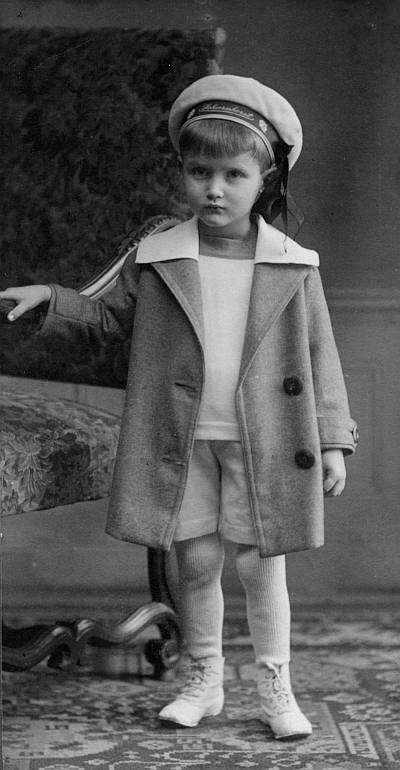
German Sailor Caps: Tallies, Ribbons, and Streamers

Figure 1.--German sailor caps came with varying combinations of tallies (cap head band), side ribbons, and streamers. Here we see a boy with a side ribbon. The cap tally reads "Scharnhorst". Gerhard Johann David von Scharnhorst was a Prussian generalPrussian general who developed the general staff system of militay command. (The Germans did not have a lot of admirals to name ships after.) Of course the famous battle cruiser "Scharnhorst" was a World War II ship. The image here dates to the World War I era. Put your cursor on the image for a closer look. Image courtesy of the BP collection.
|
German sailor caps came with varying combinations of tallies (cap head band), side ribbons, and streamers. The tally was the cap band that had the name of the sailor's ship. It was normally black silk with the ship name in gold or white. Many sailors saved these tallies as they were transferred to new ships. This tradition was continued for boys. Sometimes the names of famous ships were used. Other times terms like "Kaiserliche Marine" or Deutche Marine". Other tallys had "Deutchland" or the name of a region like "Rhineland". We also notice boys wearing ribbons at the side of the cap. These were often tied into bows. These side ribbons became much less common after the War. Actual uniform caps did not have these side ribbons. Ribbons often were worn haning down the back which were called streamers. Often caps had two streamer. Actual uniform caps has streamers, but often were shorter than the ones boys wore.
The tally was the cap band that had the name of the sailor's ship. It was normally black silk with the ship name in gold or white. Many sailors saved these tallies as they were transferred to new ships. This tradition was continued for boys. Almost all German sailor caps had these tallies. Sometimes the names of famous ships were used. This could be a famous battle ship. Or during the War exploits of particular ships like the U-9 were reported in the press. Thus ypu see the boys with tallies that have these ship names. Other times terms like "Kaiserliche Marine" or Deutche Marine". Other tallys had "Deutchland" or the name of a region like "Rhineland". This could represent where the boy was from. Or it could represent a political statement. The Rhineland was, gor example, occupied by the French after World War I to compel the payment of reparations. We also notice a variety of other words sich as "Regatta" which have naval connotations.
Side Ribbons
We also notice boys wearing ribbons at the side of the cap. Not all caps had these side ribbons, but a number did. These were often tied into bows. These side ribbons became much less common after the World War I. Actual naval uniform caps did not have these side ribbons.
Streamers
Ribbons often were worn hanging down the back which were called streamers. Streamers were very common on sailor caps. Often caps had two streamer. Actual uniform caps has streamers, but often were shorter than the ones boys wore. It is particularly difficult to assess because they do not show up in portraits which are almost always frontal shots. A reader asks, "I wonder if the streamers came from the name of the ship which would be on the sailor cap and that would explain why the streamers were smaller on the adult versions as compared to the child's version. I never thought about
this till I read your comment below and now it seems to make sense. Of course, this is just speculation on my part but if a name of a ship was purchased you could then sew it to a cap and the left over would form a streamer. That way a plain cap could easily be customized. Do you know
whether there is any truth to this speculation of mine?" HBC has no information here. Perhaps some readers will have an insight here.
HBC

Navigate the Boys' Historical Clothing German pages:
[Main German sailor cap page]
[German choirs]
[German scouts]
[Hitler Youth]
[German school uniforms]
[German royalty]
[German sailor suits]
[Lederhosen]
[Ethnic]
[Tights]
[Long stockings]
Navigate the Boys' Historical Clothing Web Site:
[Introduction]
[Activities]
[Biographies]
[Chronology]
[Clothing styles]
[Countries]
[Bibliographies]
[Contributions]
[FAQs]
[German glossary]
[Satellite sites]
[Tools]
[Boys' Clothing Home]
Created: 7:30 PM 10/12/2006
Last updated: 7:30 PM 10/12/2006



